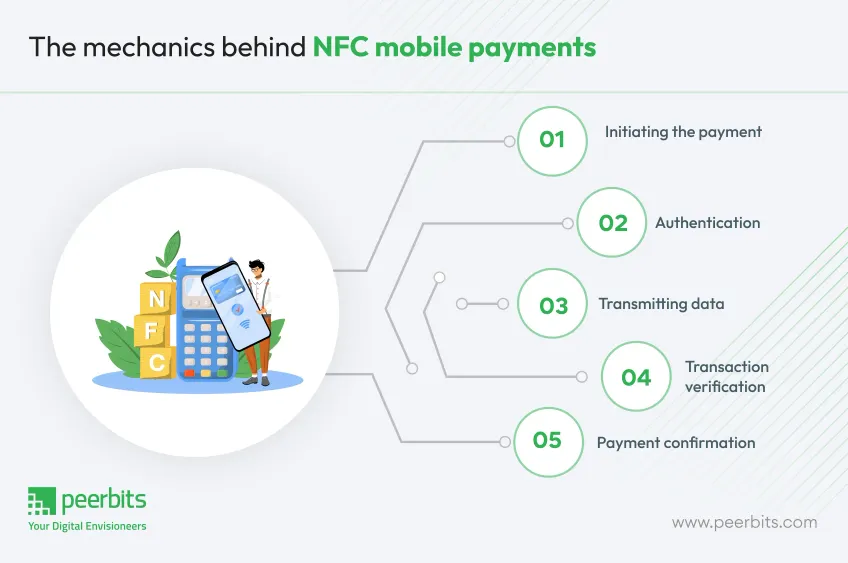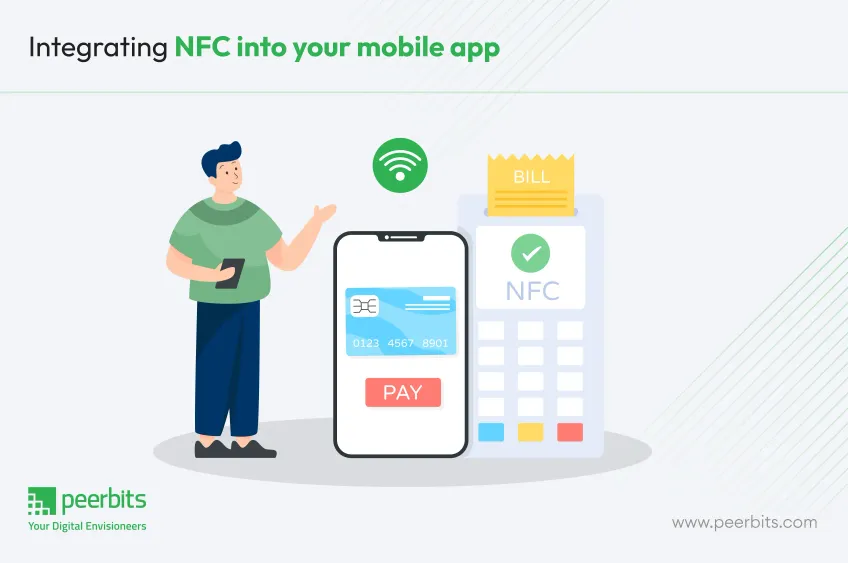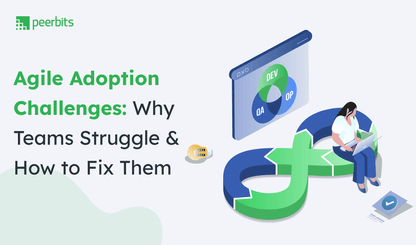NFC technology is changing the payment systems by making transactions quicker, more convenient, and secure. Traditional payment methods, like cash or credit cards, were often slow and prone to errors.
With NFC, payments are now contactless, speeding up checkout processes for retailers and letting commuters use their phones or smartwatches for transportation, eliminating physical tickets.
For businesses, NFC payments enhance security through encryption and tokenization, while offering a faster experience for tech-savvy consumers. As mobile payments rise, adopting NFC will help businesses stay competitive and improve operational efficiency.
A mobile app development company can help integrate NFC technology into apps to streamline these payment processes.
In this blog, we’ll explore how NFC is improving payment systems for businesses and consumers.
What is NFC and why does it matter?
NFC (Near Field Communication) is a wireless technology that allows devices to communicate when placed close together, typically within a few centimeters.
It uses electromagnetic fields to transfer data between devices without needing physical contact. This makes NFC ideal for mobile payments, ticketing, and other similar functions.
Key applications of NFC beyond payments
NFC extends beyond mobile payments and is used in several industries. In transportation, it allows for contactless ticketing, where commuters can use their smartphones to access trains, buses, or metros.
It also plays a role in access control, replacing traditional keys with NFC-enabled devices or cards. NFC is also used for data exchange, such as pairing Bluetooth devices or transferring files between phones.
Why NFC matters?
NFC is important because it simplifies transaction processes, reducing the time spent on checkouts and other interactions. In mobile apps, NFC supports secure, contactless payments, making it easier for users to complete purchases.
This technology also improves security by using encryption and tokenization to safeguard sensitive data during transactions.
How NFC payments work?

An NFC payment follows a simple yet efficient process that allows users to complete transactions with a tap of their mobile device. Here’s how it works:
-
Initiating the payment: To start an NFC payment, the user opens their payment app, such as Google Pay or Apple Pay, on their mobile phone or smartwatch. The device must have NFC functionality enabled.
-
Authentication: Before proceeding with the payment, the app verifies the user's identity. This could be through biometric authentication, such as fingerprint or facial recognition, or PIN entry.
-
Transmitting data: Once the user authenticates, the mobile device transmits encrypted payment data to the merchant’s point-of-sale (POS) terminal via NFC technology. The transaction data is sent securely using radio frequency signals.
-
Transaction verification: The POS terminal receives the data and checks with the payment processor or bank to ensure the transaction is valid. If the funds are available and the transaction is authorized, the payment is approved.
-
Payment confirmation: The user receives a notification or confirmation on their mobile device indicating that the payment was successful. At this point, the transaction is complete, and the user is free to go.
Popular NFC payment platforms
Several platforms have popularized NFC payments, offering businesses and consumers a fast, secure, and easy way to process transactions:
-
Google Pay: Google Pay lets users make NFC payments using their smartphones or wearables. It supports a wide range of cards, loyalty programs, and transit passes, making it a versatile option for mobile payments. Android app development services helps integrate these features smoothly for an enhanced user experience.
-
Apple Pay: Apple Pay is available on iPhone, iPad, and Apple Watch, allowing users to make NFC payments securely. With features like Face ID, Touch ID, and card tokenization, it offers a high level of security.
-
PhonePe: This India-based payment app integrates NFC technology for quick, secure mobile payments. It supports various payment methods, including credit/debit cards, UPI, and wallets.
-
Visa payWave: Visa payWave is a contactless payment method that uses NFC technology for fast, secure transactions without the need for a physical card swipe. It is accepted by many merchants worldwide.
-
MasterCard PayPass: Similar to Visa payWave, MasterCard PayPass uses NFC for contactless payments. Users can pay by tapping their card or mobile device at compatible terminals, providing a quick checkout experience.

Why integrate NFC into mobile apps?
Integrating NFC into mobile apps offers numerous advantages for both businesses and users. Let’s explore these benefits in more detail.
Benefits for businesses
Integrating NFC into mobile apps offers several advantages for businesses, transforming both customer experience and operational efficiency. Here's how:
Increased customer satisfaction:
- Businesses provide a more convenient and hassle-free experience by offering contactless payment options through mobile apps.
- Customers no longer need to carry physical cards or cash, making transactions smoother and faster.
- This ease of use can boost customer loyalty and satisfaction, encouraging repeat business.
Reduced transaction times:
- NFC payments are quicker than traditional card or cash payments, helping businesses reduce checkout times.
- With a simple tap, payments are completed instantly, reducing queues and wait times, especially in high-traffic locations.
- This lets businesses handle more transactions in a shorter period, improving efficiency.
Higher security:
- NFC payments use encryption and tokenization to protect sensitive financial information.
- This added layer of security helps businesses minimize the risk of fraud, chargebacks, and data breaches.
- Ensures both the company and its customers are protected.
Benefits for users
For users, NFC payments offer a smooth experience, bringing several benefits:
Convenience:
- Users can make payments using their smartphones or wearables, eliminating the need to carry cash or cards.
- With just a tap, they can complete transactions quickly and easily.
Speed:
- NFC transactions are almost instantaneous, making them much faster than traditional methods.
- This speed not only improves the user's experience but also reduces wait times at checkout counters.
Fewer touchpoints:
- NFC reduces the need for physical contact during transactions, making it a safer option, especially in today's world where hygiene and safety are top priorities.
- Users can pay by simply tapping their devices, minimizing direct contact with terminals and cash.
Security concerns surrounding NFC payments
Security is a primary concern for NFC payments. While this technology offers convenience, it also presents potential risks. In this section, we’ll explore common security threats and address misconceptions about NFC payment safety.
Here are some common threats:
- Eavesdropping: Attackers could intercept communication between two NFC-enabled devices, although the short-range nature of NFC makes this difficult. It remains a risk in environments with weak encryption or poor security protocols.
- Data manipulation: If NFC communication isn’t properly encrypted, malicious actors could alter transaction details. Tokenization and encryption help minimize this risk.
- Device theft: Stolen devices pose a threat if unauthorized users attempt to make payments. However, most modern devices use biometric authentication, reducing this risk.
Myths vs. realities: Address misconceptions about NFC security
There are several misconceptions about NFC security that need clarification:
| Myth | Reality |
|---|---|
| NFC payments are unsafe because they transmit data wirelessly | NFC transactions are encrypted and use tokenization, ensuring data is not transmitted as plain text. The short range of NFC (a few centimeters) makes interception difficult. |
| NFC is easy to hack and steal information | NFC technology has multiple security layers, such as encryption and authentication, which significantly reduce the chances of hacking or data theft. |
| NFC payment apps don’t provide enough protection for stolen devices | Most NFC payment apps incorporate strong authentication methods like PINs, fingerprints, and facial recognition, making it nearly impossible for stolen devices to be used for unauthorized payments. |
NFC payments, when implemented with the right security measures, are safe and offer a secure way to handle transactions.
Strategies to improve NFC payment security
To enhance NFC payment security, several strategies can be implemented. Let’s see how:
Proximity restrictions
NFC payment technology operates within a very close range, within a few centimeters, making it challenging for attackers to intercept the communication.
This proximity requirement limits the chances of unauthorized access, as potential hackers would need to be very close to the user’s device to manipulate or intercept the transaction, enhancing security for users.
HCE and secure elements
Host Card Emulation (HCE) and Secure Elements (SE) are two critical technologies used to enhance the security of NFC payments.
-
HCE (Host Card Emulation): HCE (Host Card Emulation) lets smartphones emulate payment cards using software and secure cloud systems, reducing the risk of physical card theft by encrypting payment data in the cloud.
-
Secure Elements (SE): Secure Elements (SE) are tamper-resistant chips within devices that store payment information securely, isolated from the operating system to prevent unauthorized access and protect data during transactions.
Multi-factor authentication:
Multi-factor authentication (MFA) is becoming a standard practice in improving NFC payment security. MFA requires users to authenticate their identity using two or more methods:
- Something the user knows (PIN or password)
- Something the user has (a mobile device, token, or authentication app)
- Something the user is (biometric factors like fingerprints or facial recognition)
This multi-layered system makes it much harder for unauthorized individuals to access accounts or make payments. If one factor is compromised, the other layers continue to protect the user's data and prevent fraudulent activities.
Integrating MFA into NFC payment systems provides an added level of security, safeguarding against unauthorized access and fraud.
How can businesses integrate NFC into mobile apps?

Integrating NFC into mobile apps can significantly benefit businesses by improving payment efficiency, customer satisfaction, and security. Below are key steps for business leaders to consider when incorporating NFC functionality into their mobile apps.
Tools and frameworks: Choosing the right technologies
To integrate NFC successfully, businesses need to collaborate with developers who are familiar with the appropriate tools and frameworks. For Android apps, developers generally use the Android NFC API, while for iOS, Core NFC is the preferred framework.
Choosing the right platform and ensuring compatibility with NFC payment solutions like Google Pay or Apple Pay is critical for creating smooth experiences for users.
Testing and compliance: Ensuring quality and security
It's essential for businesses to prioritize rigorous testing of the NFC functionality to ensure its reliability and security. The app must comply with industry standards, such as PCI-DSS, to safeguard sensitive customer information during transactions.
Testing NFC payments across various use cases helps prevent errors and ensures that the mobile app meets user expectations while protecting data.
Collaboration with payment processors: Choosing reliable payment gateways
For successful NFC payment integration, businesses should partner with trusted payment processors. Working with established payment gateways ensures that the app supports secure and efficient transactions, meets compliance standards, and offers scalability.
This partnership can help businesses offer a smooth payment experience while minimizing risks associated with payment fraud.
Potential drawbacks of NFC payments
While NFC payments offer significant benefits, businesses should also be aware of potential challenges that could affect implementation and user experience.
1. Limited device compatibility
One key challenge with NFC payments is that not all devices support NFC technology. While most modern smartphones do, older models or budget devices may not have the necessary hardware.
This can limit the reach of NFC payment solutions and impact user adoption, especially if businesses are targeting a broader customer base.
2. Infrastructure requirements
Incorporating NFC payments into a mobile app often requires businesses to update their payment infrastructure. Some older point-of-sale (POS) systems may not be NFC-compatible, requiring businesses to invest in new hardware to accept NFC transactions.
This can add additional costs and operational complexities for businesses, especially small and medium-sized enterprises.
3. Regional adoption challenges
The adoption of NFC payments varies by region, with some areas embracing the technology faster than others. Businesses operating in regions with lower NFC adoption may face slower customer uptake, as users may not be accustomed to using mobile wallets for payments.
This disparity can impact the effectiveness of NFC payment integration in certain markets, requiring businesses to customize their strategies based on regional trends. Ewallet app development can help businesses customize their solutions to meet the needs of different markets.
Future of NFC in mobile payments
NFC in mobile payments is expected to grow, with businesses seeing new opportunities and advancements as adoption rises. Emerging technologies will influence the future of NFC payments.
Growth in emerging markets
The adoption of NFC payments is growing rapidly in emerging markets, where mobile payments are often more accessible than traditional banking methods.
In countries where smartphone penetration is increasing, NFC technology offers an efficient and secure way for consumers to make payments without the need for physical bank infrastructure.
As mobile payment solutions like NFC become more widespread, businesses in these regions can tap into a growing consumer base that prefers convenient, contactless payment options.
Innovations on the horizon
The future of NFC payments includes exciting advancements like blockchain integration for added security and transparency. IoT could enable payments through smart devices, while AI might offer real-time fraud detection and personalized experiences.
These technologies promise to expand NFC’s capabilities and value for both businesses and consumers.
Conclusion
NFC technology has transformed mobile payments, offering speed, convenience, and secure transactions. Businesses adopting NFC payment systems can improve customer experiences and streamline operations.
While challenges like device compatibility and infrastructure costs exist, staying updated on mobile app development trends and exploring new technologies like blockchain and IoT can help businesses stay ahead.
NFC continues to grow globally, making it an essential tool for businesses looking to adapt to the changing payment landscape.









